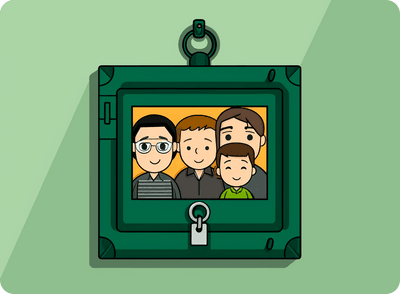At Ente, we believe that your photos are your priced possessions and that they deserve to be stored with absolute privacy. So we use end-to-end encryption (E2EE) to protect your photos from anyone who might want to access them without your permission.
In this article, we will explain what end-to-end encryption is, how it works, and why it's necessary to protect your photos with it.
What is End-to-End Encryption?
Encryption is a process of transforming data into an unreadable format using a secret key. Only those who have the key can decrypt the data and access its contents. Encryption is used to protect your data from unauthorised access, such as hackers, government agencies, or malicious third parties.
There are different types of encryption, depending on who holds the keys and
where the data is encrypted. For example, when you visit a website that uses
HTTPS (like this one!), the data you send and receive is encrypted in transit.
This means that the data is encrypted while it travels between your device and
the website's server, so no one in the middle can intercept or access it.
However, the website's server can still decrypt your data and read its contents.
Encryption-in-transit and encryption-at-rest are both better than no encryption at all, but it still has some drawbacks. For one, you have to trust the website or service provider to keep your data safe and not misuse it. For another, your data can still be compromised if someone gains access to the server.
End-to-end encryption (E2EE), or client-side-encryption is a form of encryption that ensures that only you or the people you choose, can access your data. With E2E encryption, your data is encrypted on your device before it leaves it and remains encrypted until it reaches the other end (your device or that of your friend). No one in between, not even the server can decrypt or modify your data. Only you hold the decryption keys.
How does E2EE work for Photos?

Photo storage is one of the applications where E2E encryption is especially useful and important. Photos are often personal and sensitive, containing information about your identity, location, activities, preferences, and the depth of your relationships. You may not want anyone else to see or use your photos without your permission.
However, many photo storage services do not use E2E encryption or use it only partially. For example, Google Photos uses server-side encryption for storing your photos on its cloud servers, but it also analyses and processes your photos for various purposes, such as creating albums, enhancing quality, generating animations, recognising faces, and providing search features. This means that Google has access to your photos and can use them for its own benefit or share them with third parties.
At Ente, we use end-to-end encryption. Your photos are encrypted on your device using a unique key that only you have. We do not store or transmit this key anywhere. Your photos remain encrypted until you view them on your device using our app. We do not have access to your photos or keys at any point.
Although your photos are E2E encrypted, we use intelligence on the client side to organize your photos and make them searchable by date, location, descriptions, etc. Ente also lets you share your albums with your loved ones, and collaborate on them, end-to-end encrypted.
Why is E2EE important for Photos?
End-to-end encryption offers several advantages over server-side encryption or for photo backups. Some of the benefits are:
Privacy: With E2E encryption, you have full control over who can access your photos. You don't have to trust a third party to protect your privacy. You can be sure that no one can access your personal information without your consent.
Security: With E2E encryption, your photos are protected from cyberattacks, data breaches, or accidental leaks – many of which have happened in the recent past 1 2. Even if there is an accidental data leak (because bugs 🐞!), or someone hacks into the servers hosting your data, no can access them without your key.
Protection Against Surveillance: E2EE safeguards against large-scale surveillance by corporate and government entities. This protection is crucial for journalists, activists, and others who might be at risk from entities trying to intercept and read their communications. Privacy is after all a fundamental human right.
Conclusion
End-to-end encryption is a powerful and essential feature to protect your photos on the cloud. It ensures that only you and the people you choose can access your photos. It protects your photos from unauthorised access, cyberattacks, data breaches, and accidental leaks.
Ente is an open-source app that automatically backs up and organises your photos with end-to-end encryption. We respect your privacy and security at every level. We do not have access to your photos, keys, metadata, passwords, or anything else. We do not track or analyze your behaviour or usage. We do not show any ads or sell your data to anyone.
If you are looking for a secure and private alternative to store your photos online, you should give Ente a try. You can download it from Google Play or App Store and get started with a free plan. If you are someone who cares about your privacy, you will likely like us.